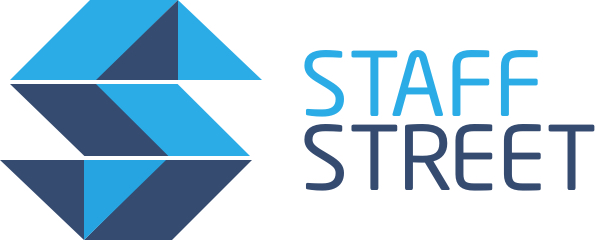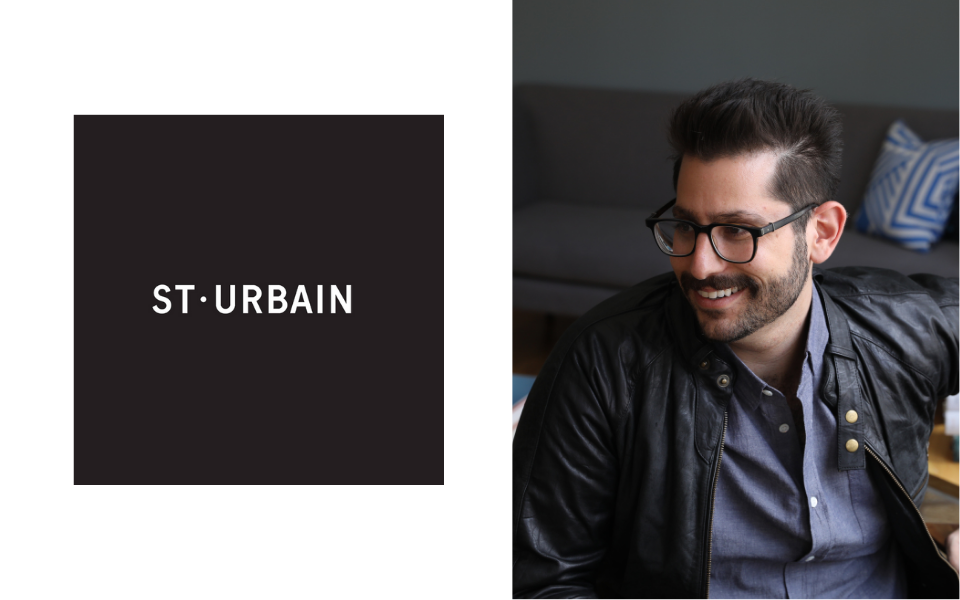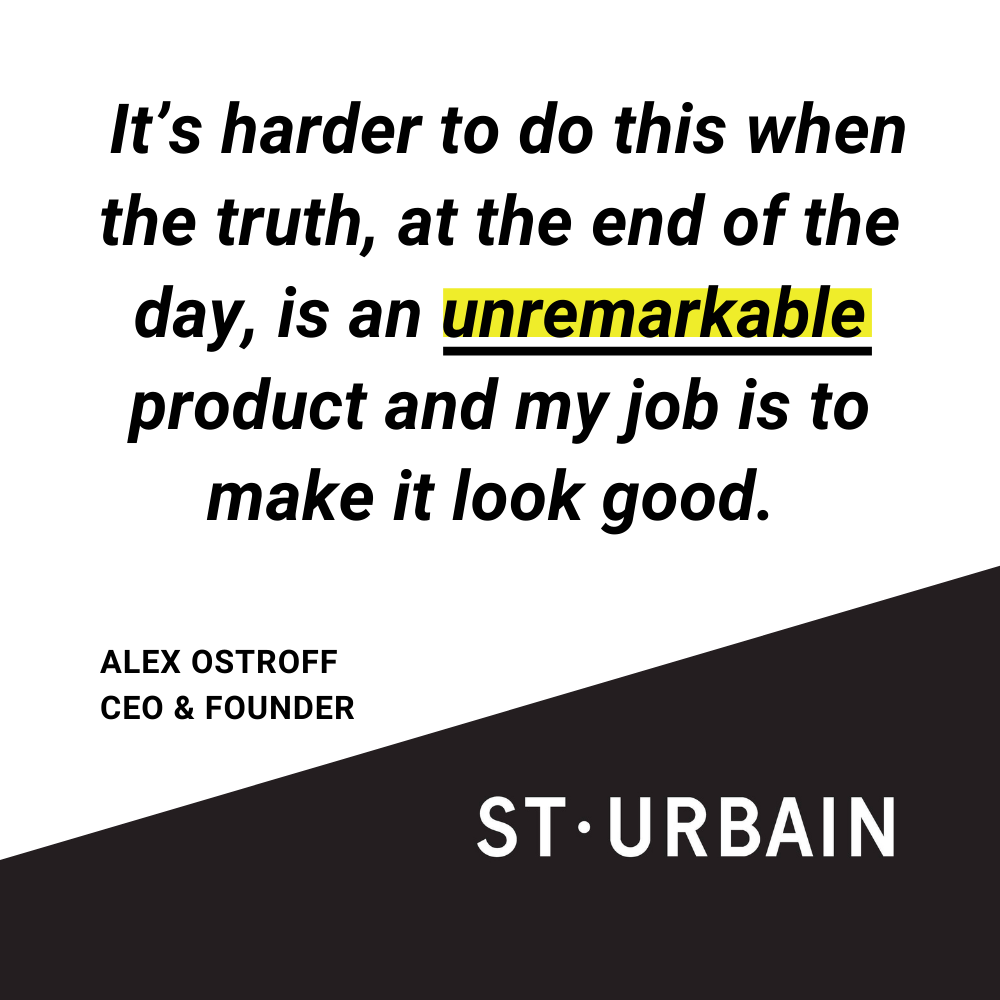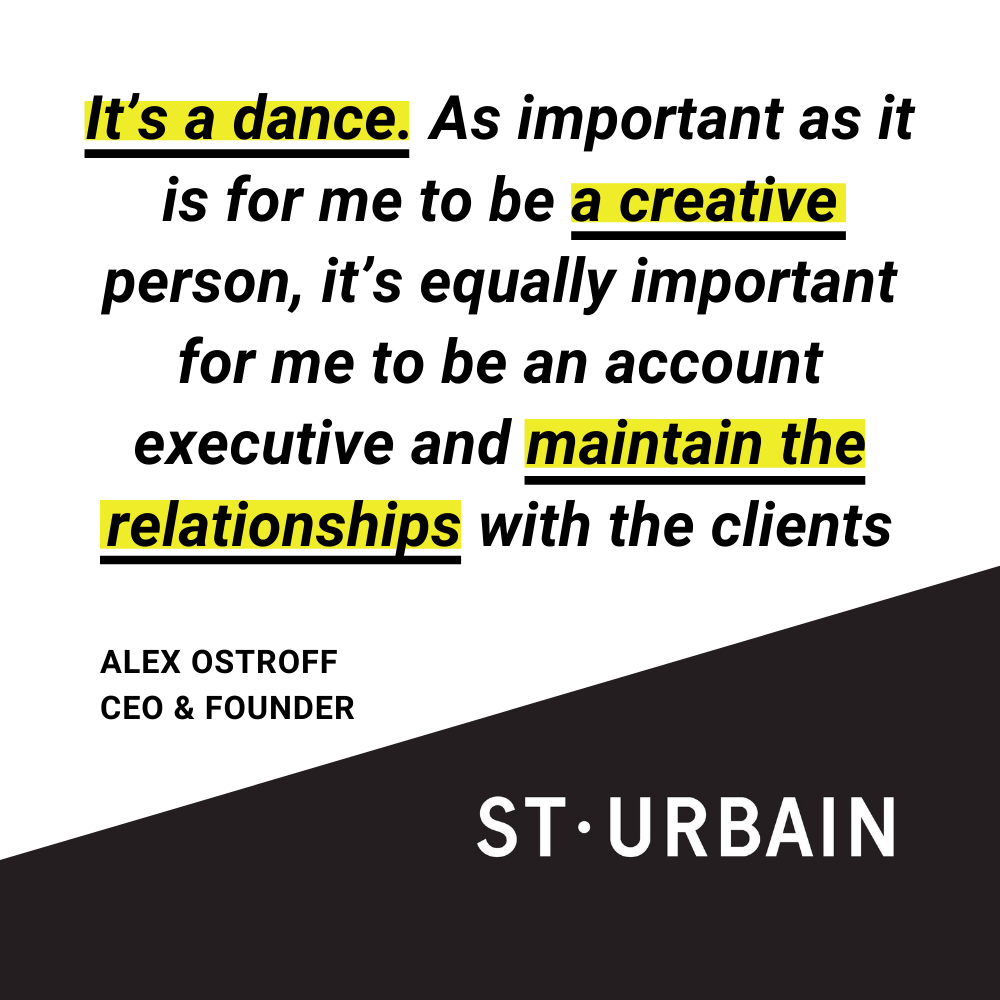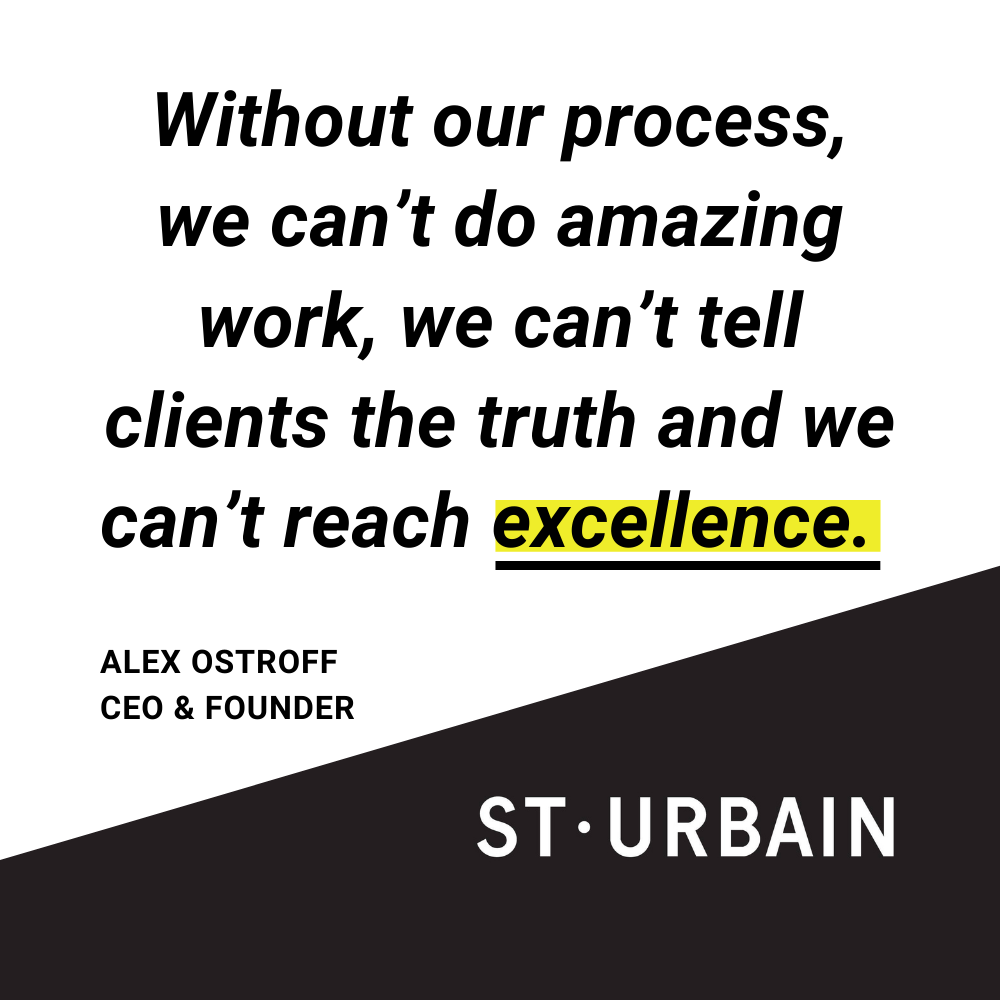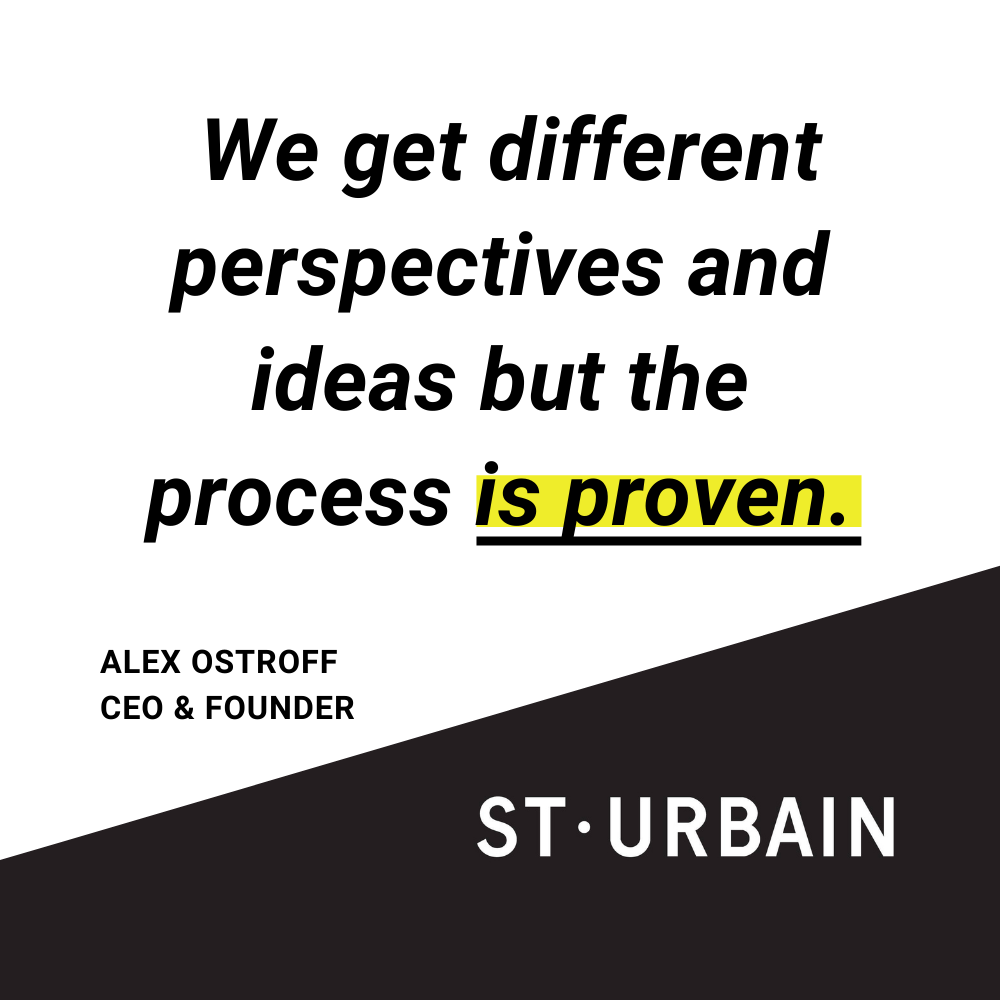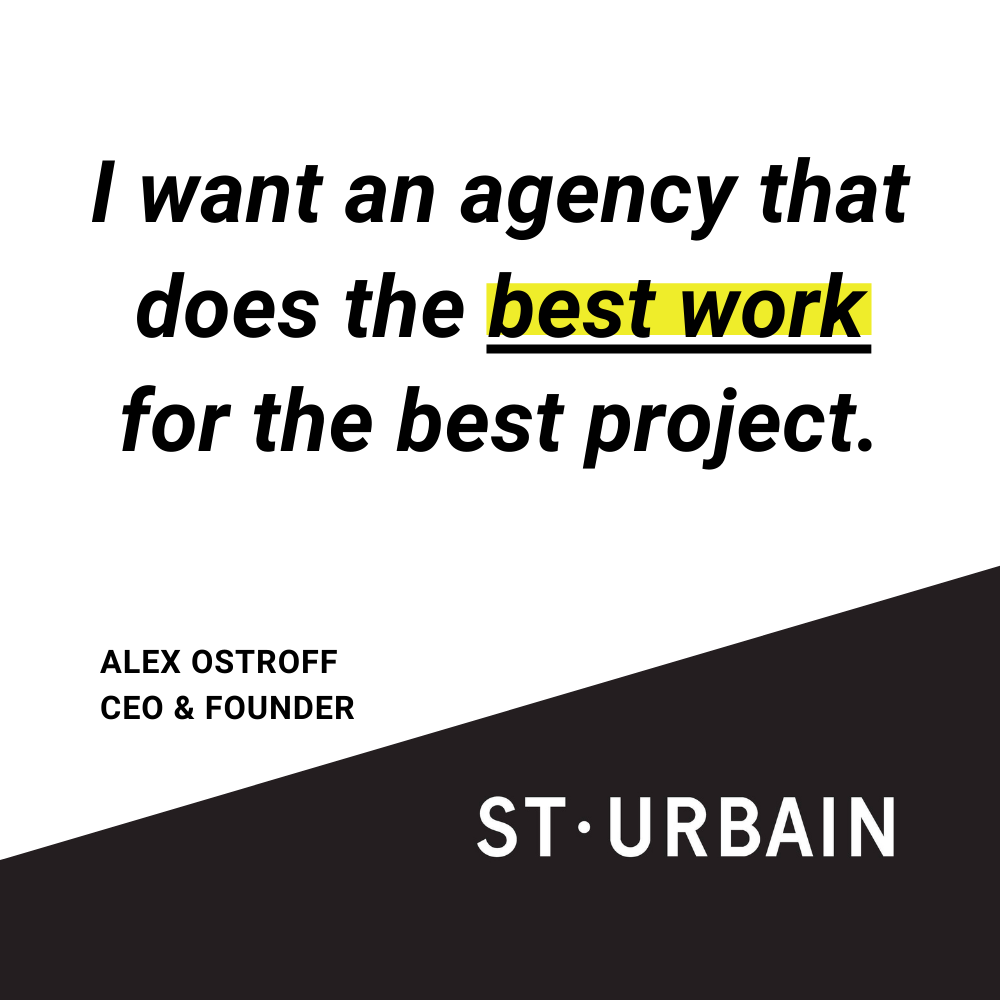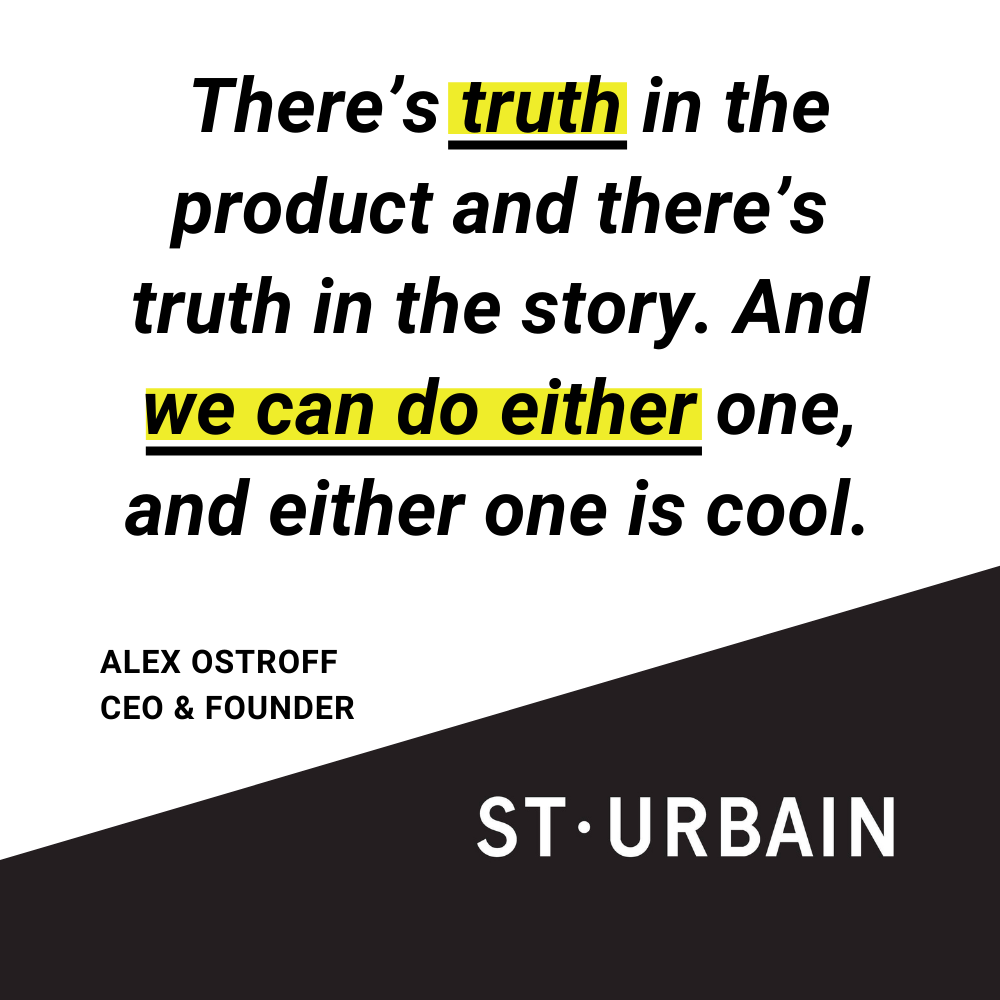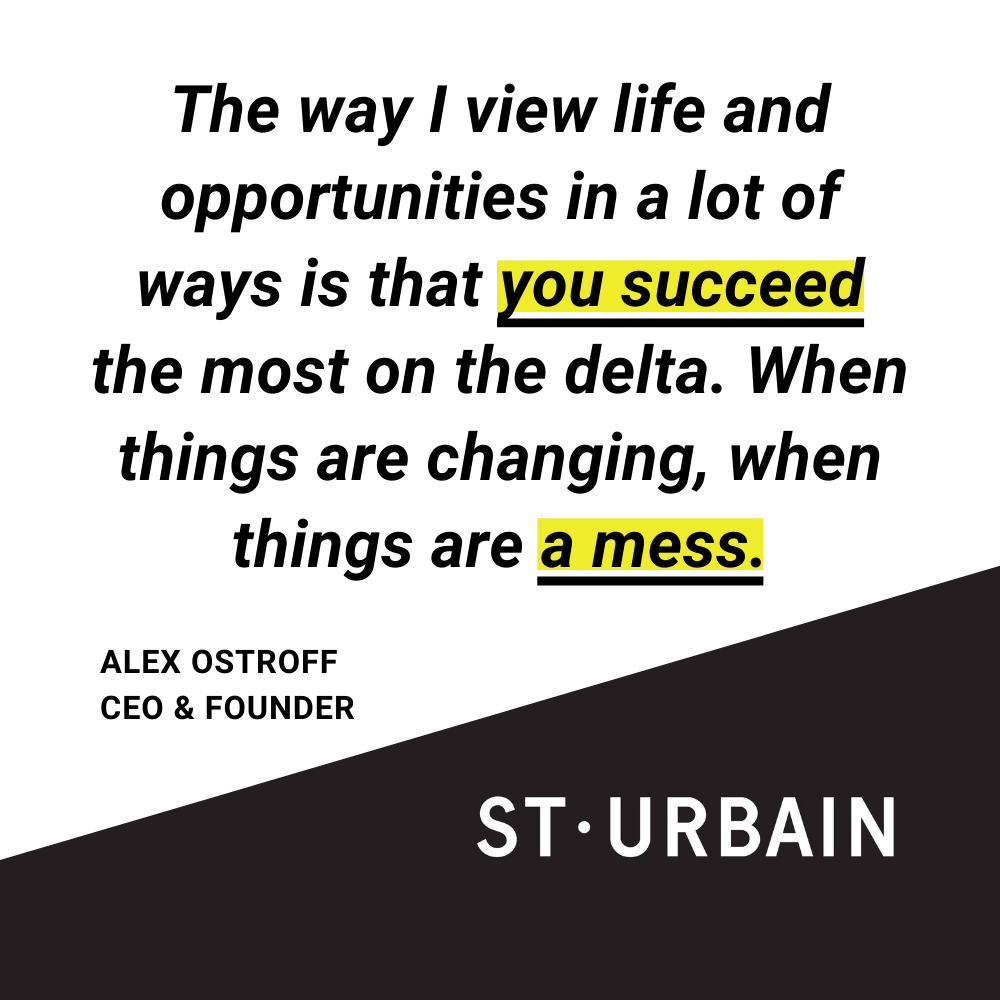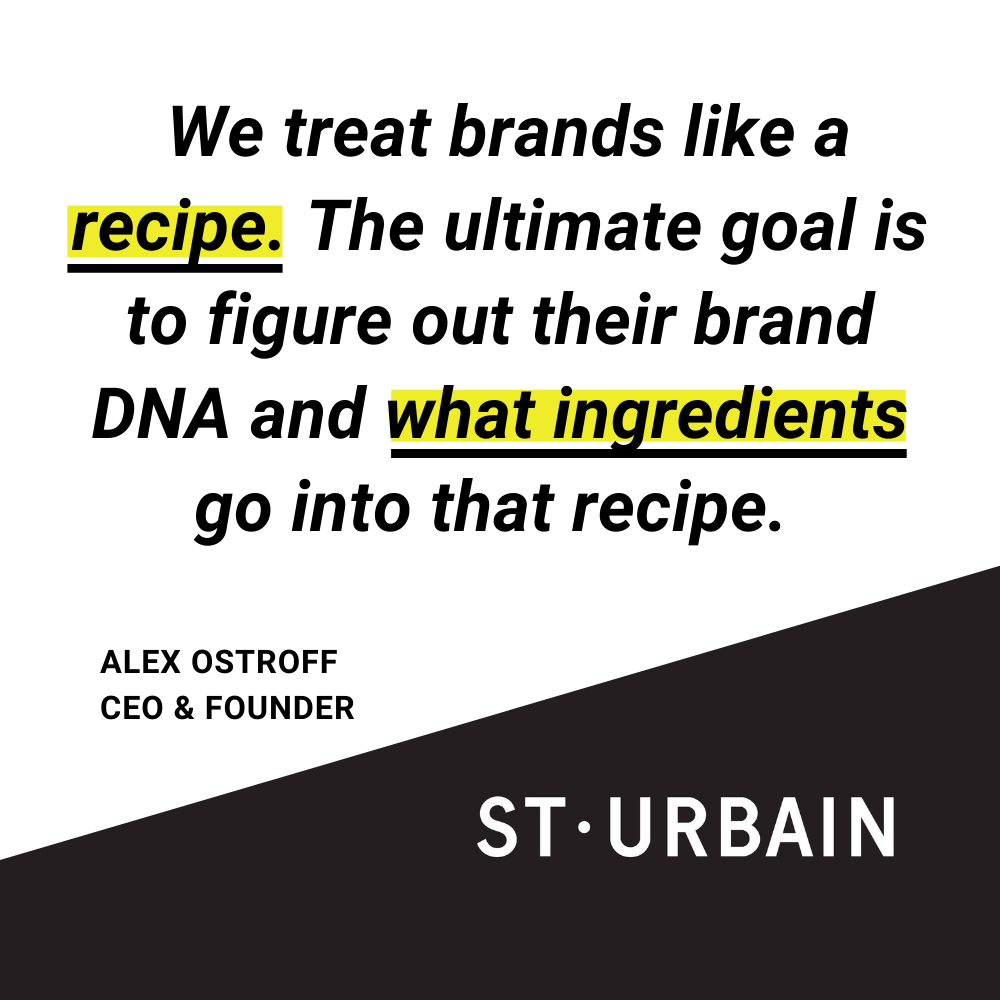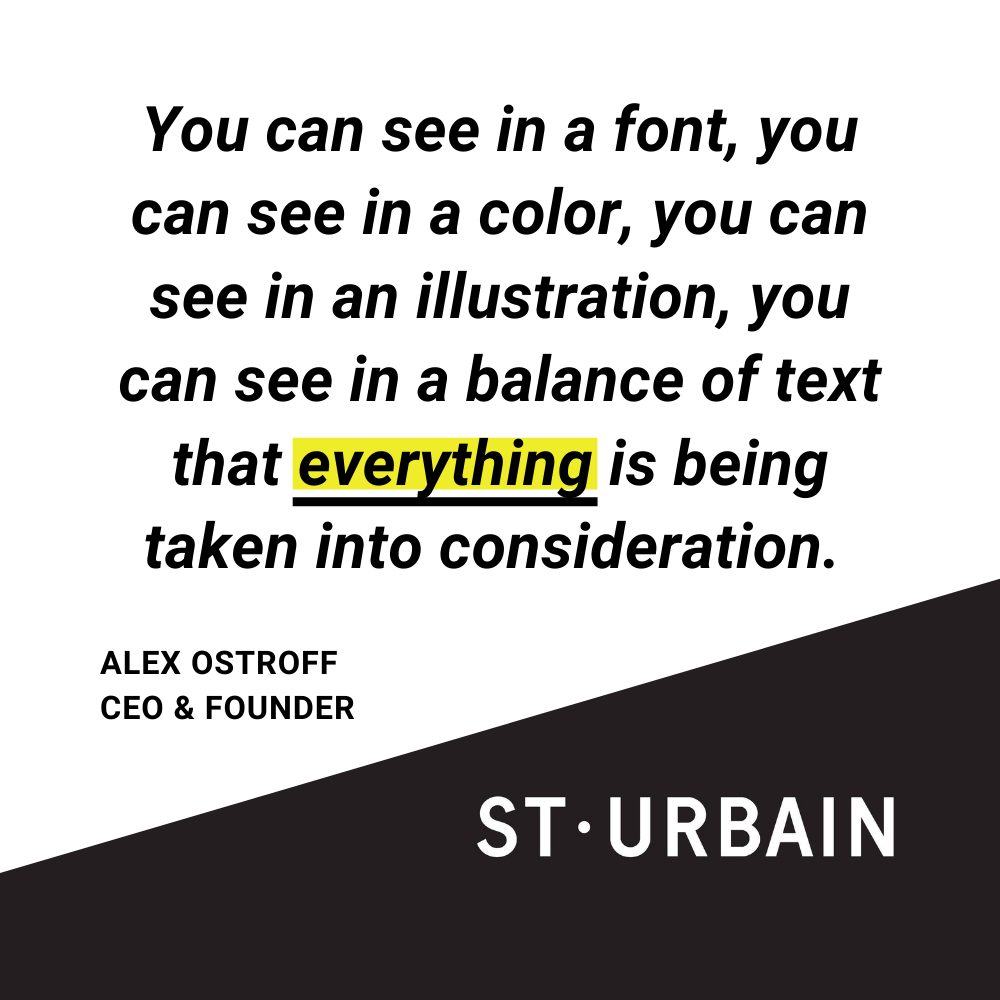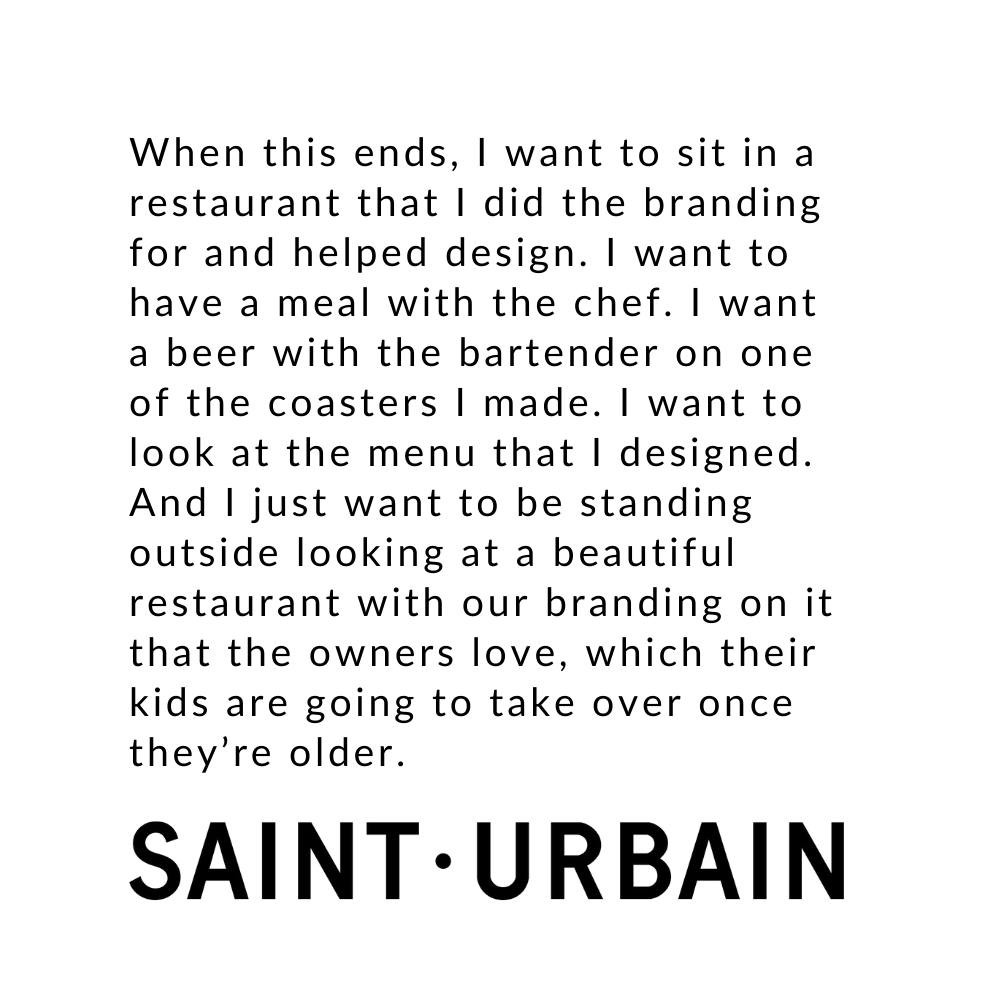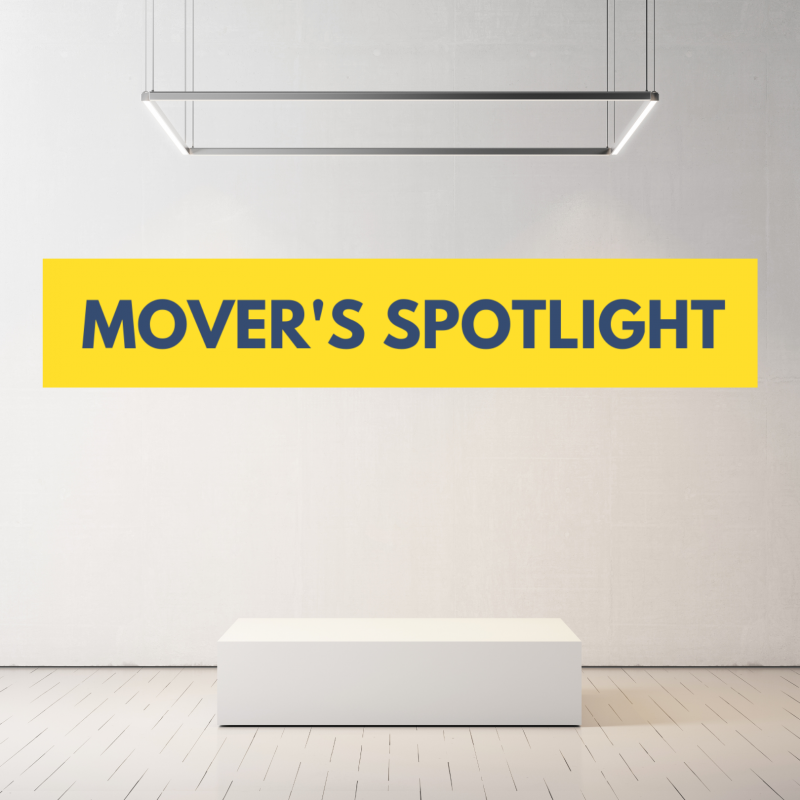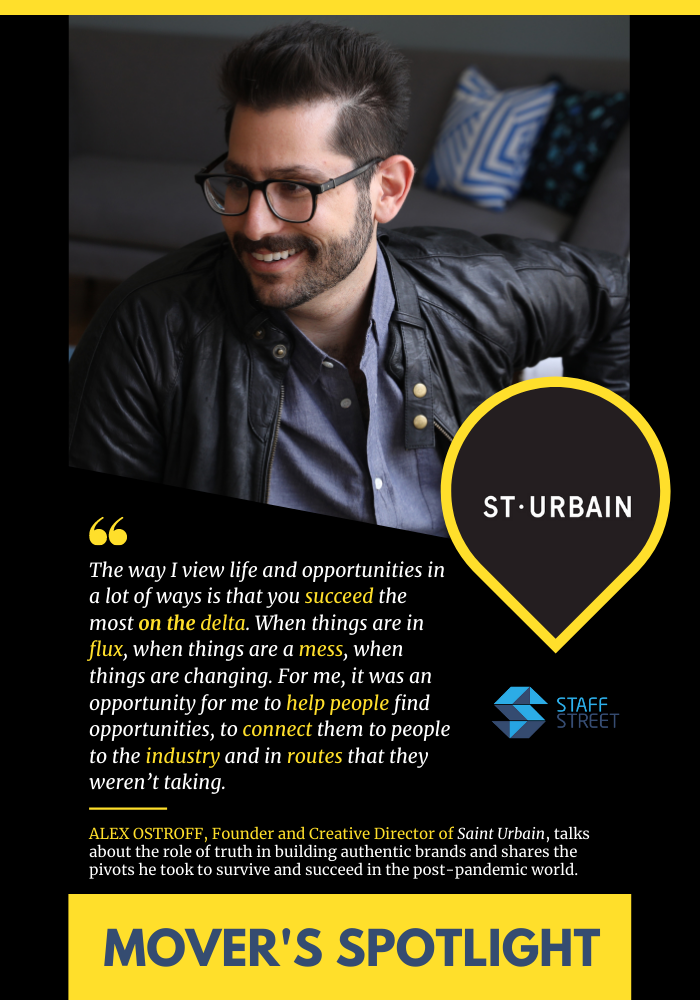
Before we get into Saint-Urbain, I want to talk about you first. How did you personally get into the creative and design industry?
Alex Ostroff: Long before Saint Urbain, I went to film school in Montreal, Canada, where I’m from. And I loved it. I was on track for film. Now, I’m a huge foodie. Even then, I loved going to restaurants all across Montreal. And I became friendly with restaurant owners. Because I was a designer, I would offer to do logos and branding and menus. That was just a way for me to be creative. I was in school, I would make some money to pay my way through school. Then after film school, I started working for a pharmaceutical company. It was extremely boring and I hated it. But I liked my side stuff of designing for restaurants.
Eventually, I moved to New York because I wanted to live in New York. There, I helped a friend of mine. My first job was helping my friend with his family business, which was a small hotel and restaurant. While I was there, I did the same thing that I did in Montreal. I worked with restaurants in New York , and helped them with design and marketing. I would take photos for them, manage their Instagram, help with their websites and create their merch. And over time I built a lot of rapport with the local restaurant industry.
I started working with people who were starting brands. Eventually, it went from just being me to me bringing in people who are amazing and way better than me. I brought in some designers from Montreal who are amazing. Since then, Saint Urbain has grown from just me doing everything myself to having an amazing art director, photographers, and designers, who I love. And recently, I moved from New York to L.A, and we’re operating in both cities.
And now, we don’t just do restaurants or food. We’re doing fertility and wellness, and we’re getting in beauty and clothing. We’re growing.
What’s the story behind the name?
Alex Ostroff: My great-grandfather moved to Saint Urbain street from Ukraine in the 1920s. They started a family business, which was called A Ostroff, that my grandfather and father would take over when it was their time. In the 90s, they sold the business. When I was thinking of a name, I wanted something that I cared about, because I knew I would work hard if I liked the name. Saint Urbain was a way of honoring the patriarchs of my family. Plus, I work with a lot of Montreal talent, designers and illustrators.
You moved to New York, and now you’re in L.A. You work with companies all over, but you still find a way to bring it back home.
Alex Ostroff: Definitely. I love LA, I love New York, and I love Montreal. I’m aware of my roots. As an agency, we have a unique aesthetic. It’s not American, it’s not European or Canadian, it has a little of Montreal.
It’s great that you brought that up. I was going to ask you what your creative style is. Do you have a creative philosophy that guides you both in the way you create your designs and the way you run your business?
Alex Ostroff: Great question. I usually think that finding the most honest way to express a brand is the best way. I try not to lie. Instead, I try to make sure that the brands are authentic and that what they’re saying is true. At the same time, it should be what the client really wants. I want to do projects that the clients are extremely excited about. For me, it’s about finding the true story and making that story beautiful and exciting.
We’ve been lucky to work with really good entrepreneurs who have a good vision. It’s not an easy job. But if what they’re doing is interesting and their product is good, it’s easier for us to match that energy. It’s harder to do this when the truth, at the end of the day, includes an unremarkable product and my job is to make it look good. But it’s not that good. So, truth is important.
I’d like to say that we are partners in creating voices that tell amazing stories. We are working with people to find their voice, figure out what their messaging is, and help them tell their story in a beautiful and exciting way.
And when it comes to your clients, is it easy for them to find the truth in their brand, or do you often have to help them along?
Alex Ostroff: It’s different. Some clients come in with really good ideas. Some come in with bad ones. And, you know, it’s a dance. As important as it is for me to be a creative person, it’s equally important for me to be an account executive and maintain the relationships with the clients. If I don’t have that good relationship, I won’t be able to speak honestly with them.
Every time I’ve ever gotten into trouble with a project, it was because I wasn’t able to be honest with my clients. They were either too emotionally attached to an idea, or they didn’t want that kind of relationship with their creative agency. So, it’s a balance between the creative work and having a good, open communication style with your clients, where you can nurture their idea and you can bring the best version of it out, and also tell them when their idea sucks.
Is that easy to do?
Alex Ostroff: I’ve gotten better at it with every single project I’ve had. Again, it’s all dependent on the client. Now that we’re doing well as an agency, I can suss out clients early. If I can feel it from my gut or from our initial conversations that a client isn’t ideal to work with, then I will turn down a project. It’s crucial to have clients who are going to fit into our process. Because without our process, we can’t do amazing work, we can’t tell clients the truth and we can’t reach excellence.
Now I want to talk about your relationship with the people that you work with. You mentioned that you work with really great talent. They’re from all over, right?
Alex Ostroff: Yes, they’re all over. They’re Saint-Urbain people, but I also encourage them to do their freelance projects and get inspiration elsewhere. A lot of them have their own little shops wherever they do work. It’s like I have an Ocean’s Eleven team. When I have a certain project, I just assemble the best people.
Do you all share the same creative style or do you benefit from having a more varied group style?
Alex Ostroff: I would say that our perspectives are different. But the process is the Saint Urbain secret-sauce-recipe process. We do things the same time every time. We get different perspectives and ideas but the process is proven. I know exactly how many times we need to show mood boards to a client and revise it and present it and revise it and present it in order to be fully aligned on the vision before we start designing logos and packaging schemes. That’s something you learn with time, and something that I’ve standardized at Saint-Urbain.
I know that you said that you don’t necessarily represent New York or L.A., and you’re closer to Montreal. How would you describe that style – is it serious, fun, sophisticated, or would you prefer not to describe it that way?
Alex Ostroff: I prefer not to not to describe it as Montreal style. I’ve worked with designers from Hong Kong and Scotland. It’s a unique Saint Urbain style. I get inspiration from the different cities that I’ve lived in, but also anywhere in the world, any idea, any book, any bit of nature. Like, I’m curious to see your perspective. I like to think that we create a lot of personality. I’m more interested to know what you think of our style than what I think about it.
Okay. I’m not good at this but let’s see. You have a lot of different styles but I can’t say there’s one overarching style.
Alex Ostroff: I was hoping for that answer. Every project is its own unique thing for us. Every project has a specific aesthetic we’re trying to reach. It’s all about finding the truth and presenting it beautifully. Honestly, I’m not trying to run an agency that’s hipster or modern, or vintage and lame. I want an agency that does the best work for the best project.
For example, we have a project that involved, say, peanut butter. And we have two different types of clients: a client who’s really hipster and young, and a client who’s old and wants something that’s vintage, iconic, 1950s style.
At the end of the day, truth is it’s the same peanut butter. But we can represent the peanut butter in either direction. When you look at the packaging and the branding and the website and the social, it’s going to have a creamy, delicious feel to it. It’s going to be sweet, salty, and buttery, and it’s going to satisfy you.
It’s up to our client to decide whether they’re the older guy who wants you to have that nostalgic feeling. It might not be totally healthy, but it’s classic. It might be what your mom would give you when you were a kid, then you put in a sandwich and you hop on the yellow school bus.
Or if it’s this younger person who wants a very cool brand that talks about how it’s organic. Where it lists all the ingredients on the front like an RX bar. And it has vibes that will end up on Pentawards and stuff.
Ultimately, neither of them are wrong. There’s truth in the product and there’s truth in the story. And Saint Urbain can do either one, and either one is cool.
So, it comes down to working very closely with your client and trying to understand where they’re coming from and bringing that forward.
Alex Ostroff: The older guy could tell us that he wants the same project as the younger guy. He could say, “I want the hipster product with all the ingredients on the front and that tells everyone it’s organic.” We’ll do it but it would be weird if he’s the figurehead and nothing else matches that. Like, it really should suit people because they’re carrying that torch, and they are the brand in a lot of ways.
We’ve spoken with different design and creative companies. Many of them said that 2020 was a year of surprising opportunities. They were involved with a lot of projects, whether it was with companies shifting to or doubling down on e-commerce. Was it a similar experience for you?
Alex Ostroff: For sure. At the onset of the pandemic, I was really scared. I had several clients in the restaurant industry telling me that they couldn’t pay me. And it was understandable. Of course, they had to take care of their staff. Before the pandemic, 80% of our business was with restaurants in New York. What happened was, all of them paused or walked away from the projects. Basically, my whole pipeline of business said that they weren’t moving forward. I had to pay my team out of pocket. At the same time, I was living in the epicenter of the pandemic.
My lease was up in April – so, I broke it. Then, I went to Toronto to chill with family and friends. After that, I got on the phone and I started calling people in the CPG business. I had known for a while that the future of Saint Urbain was in CPG. We had worked with a few prior to the pandemic, but not as many as I wanted. So, I started calling up people in the CPG community to network and talk to them about the business.
Then, I started talking to my friends in restaurants on a personal level to convince them to create a product to sell online and in grocery stores. In my opinion, it’s worth the investment. I was able to talk a few people into doing it, connecting them to folks and repositioning their packaging design.
At the same time, I put more money into Google Ads and Social Ads. Saint Urbain, which was predominantly restaurant-based, started to become CPG-based.
The way I view life and opportunities in a lot of ways is that you succeed the most on the delta. When things are in flux, when things are a mess, when things are changing. For me, it was an opportunity for me to help people find opportunities, to connect them to people in the industry and in routes that they weren’t taking.
It was also an opportunity for me to do these things for my agency that I’ve always wanted to do. So, yeah, last year was a huge year for us. It felt like it was going to be a complete disaster in March, and by summer and fall, it felt great. And now, we’re in a good place and I’m happy and grateful.
It sounds like a rollercoaster. And I’m happy to hear you started this year on that positive note.
Alex Ostroff: Yeah, it’s better than ever now. You just have to be persistent. I did things that I hadn’t done since the last time I was looking for a job. Sending LinkedIn messages to people and cold calling and cold emailing and networking to figure things out. It was a desperate time and it yielded results.
With the online marketplace becoming super crowded and constantly changing, how should entrepreneurs balance their creative vision and their mission to appeal to the market?
Alex Ostroff: So, is your question about adapting to the way the world works in terms of selling direct-to-customer or visual norms and standards.
I guess, both. If you can speak on both, that would be great.
Alex Ostroff: Totally. It is both. For the first part, when it comes to selling your products online, it’s do-or-die. Let’s use restaurants as an example.
On the direct-to-consumer marketplace:
It’s obvious now that the people who didn’t cultivate a following on social media, and who relied on people walking by their establishment, struggled way harder than the establishments that were less good, but who cared about their social media and cared about building a following.
The people that were selling online before the pandemic were able to survive way better. Restaurants and food, specifically, who had seamless setups, who had Goldbelly set up sending their products around the world, who had great Instagram following. They could sell directly to their consumers. They could communicate with a fanbase more. That’s just one example of the benefits of being involved with social media and the digital landscape earlier.
Then, there were people who launched during the pandemic, like Omsom and other folks who launched products that ship to you. They received lots of press because they were this exciting thing that you can get sent to you in the mail. People want something that’s as exciting as going to a restaurant in their hands and on their Instagram feed, at home.
In sum, the people in CPG who had great packaging and shipping experience, and the people in restaurants who had that built-in network, did very well in this environment.
Moving forward, everyone has to get on board. People will want a more analog lifestyle after this thing ends. They’ll want to go walk to their local establishment that has no Instagram and live a life without digital shit. But now, we’re all in this lifestyle now where we make all of our decisions online and everybody has to adapt.
On packaging:
And when it comes to packaging, I don’t try to push trends on clients. They’re the ones who come to me with trends. They’re the ones who say to me, “Hey, I’m launching this granola butter. And I want all the ingredients on the front because people know what they’re eating.”
On one hand, that’s great. We’ve done projects that have been proven by data that people need to know what they’re putting in their bodies. People want to know what they’re eating.
But when they come up to me and they show me they want a product that has this or that, I don’t really like that. They’re not giving us time to figure out what’s best for them if they’re just telling me what they want.
On the trends that really matter:
It comes back to that idea of believing in data and in consumer trends that are a mainstay. People want to buy from companies that do good things to the world, that care about diversity or social justice. It’s not even about politics. From a business perspective, I truly believe that people want to buy things that they’re aligned with. And I believe that people want good things in their bodies. Those are the trends that I believe are worth incorporating.
But when people come up to me saying “I want this right here, this font, this color”, I tell them to give us time to figure out what the right thing is. It’s important to take them through our process before we can be inspired by their visual cues and visual trends. In terms of societal trends, I’m much more open to embracing them.
Speaking of trying to communicate those trends, I was talking to a brand recently and what’s particular about her brand is she’s really focused on changing the supply chain. She has this huge vision for sustainability. And she’s trying to figure out how to communicate the vastness of her project into her branding. For you, how would you communicate such huge ideas in a brand’s story?
Alex Ostroff: That’s a great question. I tell clients that we treat brands like a recipe. It’s made up of ingredients. In our moodboard alignment creation process, we do a Q&A with our clients about their brand. Keywords. Mision. Vision. Why do they exist? The ultimate goal is to figure out their brand DNA and what ingredients go into that recipe.
Some brands are like, “We’re funny and we’re organic and we give back to the world and we’re kind of hip, but we’re also kind of vintage.” And that sounds like too many things. But it’s our job at Saint Urbain that all of those key ingredients are equalling their recipe. That’s their brand.
It’s doable.
We’ve done brands where we’ve asked the clients “Is it 20% funny? Is it 50% funny?” And they’ve given us an answer. It’s actually like 28% funny, 32% vintage, and 10% blah. And, then, I get it.
If you look at our projects, you can see in a font, you can see in a color, you can see in an illustration, you can see when a copywriting is done, you can see in a balance of text that everything is being taken into consideration. So, if you look at a brand that we’ve done, you can see that this is kind of funny. Or this is kind of serious.
Like, sometimes it can’t be done if someone wants everything. It should be funny and it should be serious and we want to do good for the world but we also want to make money and it should be corporate and cold. And that doesn’t work, so, we’ll be honest.
So, we take all these ingredients and show them what it will look like, based on the fonts and color. And our clients pick out keywords and images, and we update the moodboards and the images. And we always hit homebase.
It sounds like a very straightforward process and it makes sense. Business wise, what are you looking forward to this year?
Alex Ostroff: We have lots of exciting projects which are different things outside of food, which is cool. We’re working with folks that I really admire and I’m excited about the future.
Where do you want to see Saint Urbain in a year’s time?
Alex Ostroff: That’s a great thing to talk about. In a year’s time, I want to be doing big projects. I want to work with a huge cannabis company. A film studio, creating posters for movies. I want to do the best food snacks that go viral and crazy. I want to start a catchphrase. And I want to have amazing clients and amazing projects and have them be bigger. I want to do that without scaling my agency into a big company where I don’t see every brand. I want to keep riding the wave of CPG.
But I also miss working with restaurants. So when this ends, I want to sit a restaurant that I did the branding for and helped design. I want to have a meal with the chef. And I want a beer with the bartender on one of the coasters I made. I want to look at the menu that I designed. And I just want to be standing outside looking at a beautiful restaurant with our branding on it that the owners love, which their kids are going to take over once they’re older. I have that vision, too, you know.
I want to ride the wave, which is the obvious future. And I want to go back to my life before, and use all this experience because we’re getting better all the time to do restaurants again and events and the good stuff.
